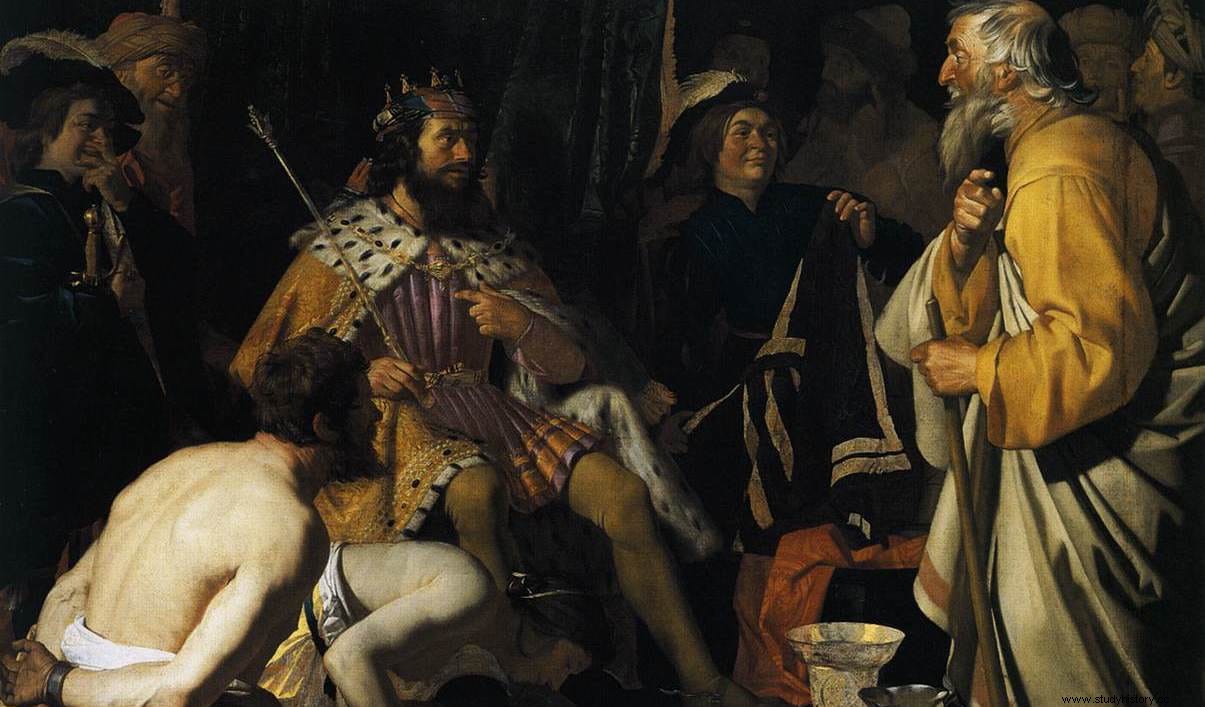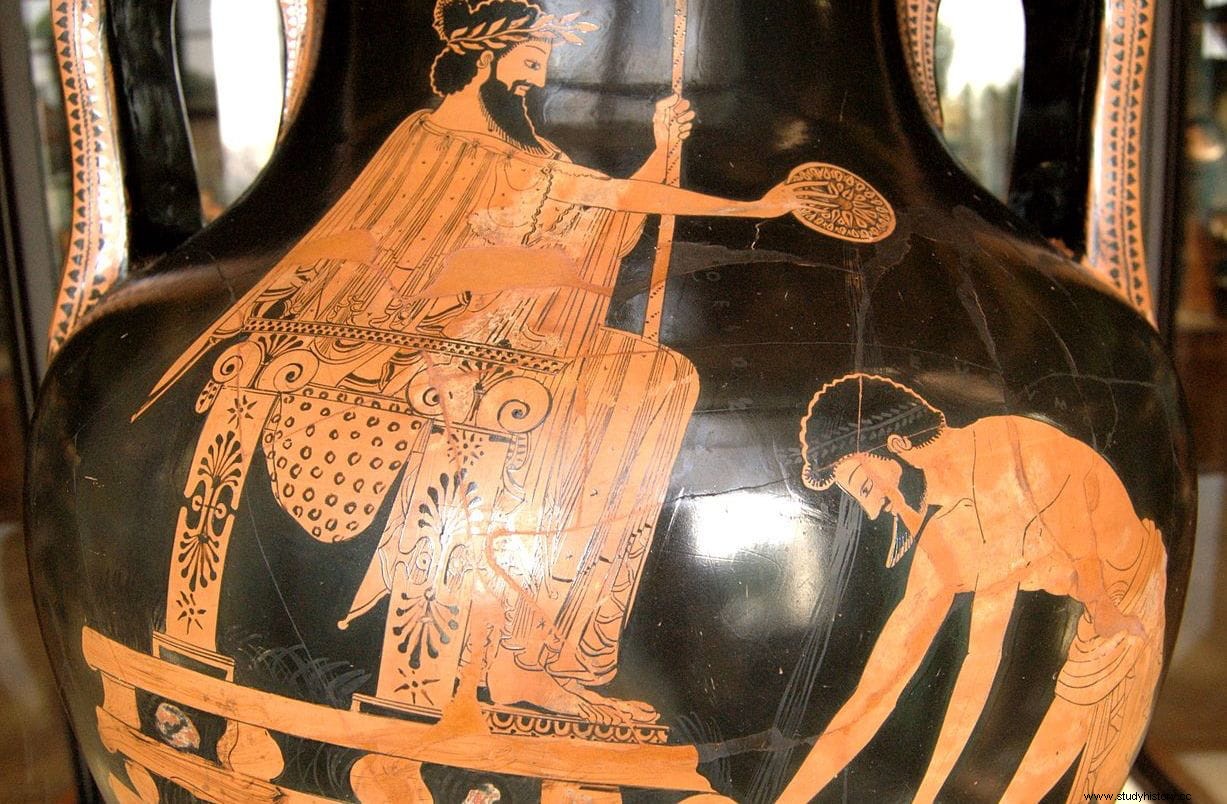Here we have dedicated several articles to the use of animals in war, some more or less normal (horses, elephants, dogs), others a little less common (pigs, cats...). The camels would be among the first but today we want to highlight their participation in the Battle of Timbrea, not because of their use per se but because of the way it was done.
The contest took place at the end of the year 547 BC. and its protagonists were, on the one hand, Croesus, king of Lydia, and on the other, Cyrus II, king of Persia. Both led the two main powers of the time and struggled to gain control of Asia Minor. Croesus belonged to the Mermnada dynasty, which had five representatives (Gyges, Ardis, Sadiates, Aliates and himself). After prevailing over his brother Pantaleón in a civil war for the succession to the throne, he led his country to a period of splendor thanks to the enrichment caused by the active minting of gold coins, a precious metal discovered in the Covenanto river (a tributary of the Hermo , current, Gediz).

The word croesus is still used today to define someone immensely wealthy and in 1965 the so-called Lydian Treasure (also known as the Karun Treasure or Croesus Treasure) was found in a burial mound in western Turkey, made up of more than three and a half hundred pieces various, many of them gold and silver. Although in reality only some objects are contemporaries of the monarch and the rest have been dated to an earlier time (7th century BC), it is a good example of the sensation that Lydian wealth caused in Antiquity, echoed by many sources. , from the Bible (Exodus ) to the Quran going through the works of Strabo, Pindar, Dio Chrysostom and, of course, Herodotus.
The latter tells that, under the government of this monarch and thanks to his powerful army, the Lydians successively conquered the surrounding territories. With the exception of Cilicia and Lycia, almost all of Anatolia remained in their hands, so that Phrygians, Mysians, Mariandians, Calibes, Paphlagonians, Thracians, Tinians and Bithynians, Carians, Ionians (except Miletus), Dorians, Aeolians, and Pamphili were subjugated. to your authority.
The prestige of Lydia was such that the wise men of Greece tried to visit the capital, Sardes; after all, Croesus was an admirer of his culture, paying for the restoration of the Temple of Artemis in Ephesus (the same one that Herostratus would later burn to achieve fame) and making large donations to the Temple of Apollo in Delphi. In fact, it was a visit to the famous oracle of that place that would trigger the tragic end of him and his country, for the Pythia prophesied that if he dared to attack the Persians he would destroy a great empire. And he was not wrong, only that the damaged empire was his.
And it is that the Achaemenid Empire was also in full expansion under the reign of Cyrus II, who was not nicknamed the Great for nothing. He was the son of Cambyses I and Mandane. This was a princess descendant of the Medo king Astyages and Aryenis, princess of the kingdom of Lydia, which is why Ciro considered that she had rights on the thrones of those countries. Consequently, he set out to conquer Media, taking its capital, Ecbatana, overthrowing and executing Astyages, and gaining control of him.

He then set his sights on Lydia, whose natural border with Media was the river Halis (modern Kizilirmak, the longest in Turkey). It so happened that Croesus was Astyages' brother-in-law, so he was obliged to intervene by marriage alliance and therefore consulted the Oracle of Delphi. The Pythia also told him that he would only lose the crown when a mule ruled Media; Croesus was satisfied without realizing that Cyrus was the offspring of a couple of different status and could be considered so. Therefore, Lydia formed an anti-Persian coalition with Egypt, Babylon and Cilicia to which the Peloponnese contributed by sending a contingent of mercenaries.
The Lydian army crossed the aforementioned riverbed to stop the invader, taking the city of Pteria, whose inhabitants he reduced to slavery. Cyrus, after unsuccessfully trying to convince the Ionians to abandon the Lydians and join him, decided to attack. His army, despite suffering considerable losses, proved far superior and forced the other to retreat towards Sardis. Part of his credit was due to his troops mounted on camels, which in that desert environment demonstrated a more effective behavior than the numerous enemy cavalry.
Croesus had to withdraw, then. Between the arrival of winter and the reinforcements promised by the Egyptian Ahmose and the Babylonian Nabonidus, he thought he would have time to reorganize to fight back and, in effect, he dismissed the Lacedaemonian mercenaries to form a powerful force with several allied contingents with whom he tripled in number. number to the enemy. But the Persians, who had not stopped waiting to catch him earlier, overtook him at Timbrea (present-day Hanaï Tepeh) and, despite everything, did not give up and put up a fight.
According to Cyropedia of Xenophon, Cyrus had 196,000 men. 20,000 were foot soldiers (including archers and slingers) reinforced by 42,000 Arabs, Armenians and Medes, plus 10,000 Immortals (part of them cavalry), 20,000 peltasts and 20,000 pikemen. There were also a thousand more troops distributed among 300 war chariots and half a dozen siege towers. Against this, Croesus had 420,000 soldiers of which 60,000 were Lydians, Babylonians and Phrygians, among other smaller numbers from the rest of Cappadocia. Likewise, Egypt contributed 120,000 infantry and 300 chariots (each with two men and, therefore, about 500 more combatants) and the cavalry added about 60,000 troops. Of course, the numbers of the Greek author have been much discussed but, in any case, they reflect the difference in size between both contenders.

The Persians spread out in a square with the infantry and towers in the center (which were mobile and were also used in pitched battles) and with the flanks protected by chariots and cavalry. As this was inferior to the fighting, it was reinforced with the aforementioned body of 300 camels, which were actually animals taken from the baggage train and whose mission was to disrupt the enemy's cavalry. To do this, two riders were arranged on each mount, back to back, one guiding the animal and the other fighting, as Ctesias de Cnido recounts in his Persica .
The Lydians took the initiative with their powerful cavalry, enveloping the Persian cadre. But in the final phase of the movement they left gaps with respect to the bulk of their army, which the adversary quickly noticed thanks to the observation from the towers and which he made sure to widen by concentrating the shots of his archers there. That caused chaos in those areas that Ciro took advantage of to send his flanking units. It is possible that the smell of the camels disconcerted the horses -it has already happened in other battles-, but the result was unbeatable:the adversary, thrown into disarray, had to withdraw with serious losses and then the Persian infantry entered the fray, crushing the Lydians.

As his people died or surrendered, Croesus was forced to escape and dig in with the survivors at Sardis, which was immediately besieged. The ensuing siege lasted two weeks and the city fell due to a group of attackers entering through a part of the wall that was not guarded, as it had an allegedly steep natural defense. Last July, an archaeological campaign brought to light remains of the war, as we reviewed in an article.
The king was taken prisoner the following year, although his fate is unclear. According to Herodotus, when he was about to execute him at the stake, Cyrus spared his life, moved to hear him invoke Solon, ending up being his adviser and recommending him to attack Tomiris, the queen of the Massagetae, on her own land (who ultimately would defeat and kill him); the poet Bacchylides, on the other hand, says that, despite this pardon, Croesus chose to die. This last ending is also reported in the Chronicle of Nabonidus (a story written in cuneiform on clay tablets).
